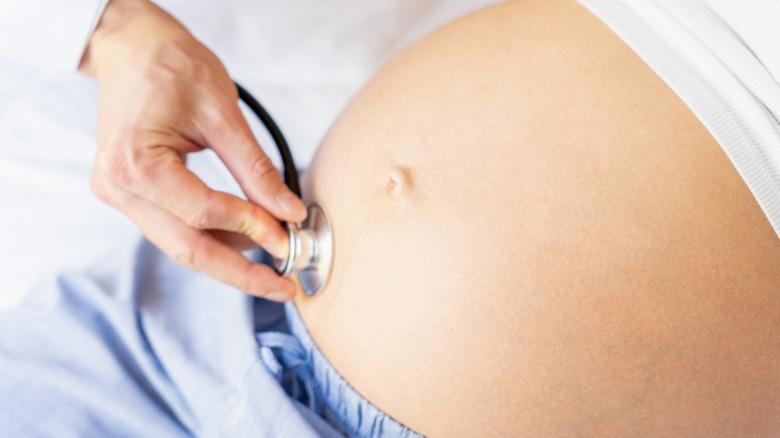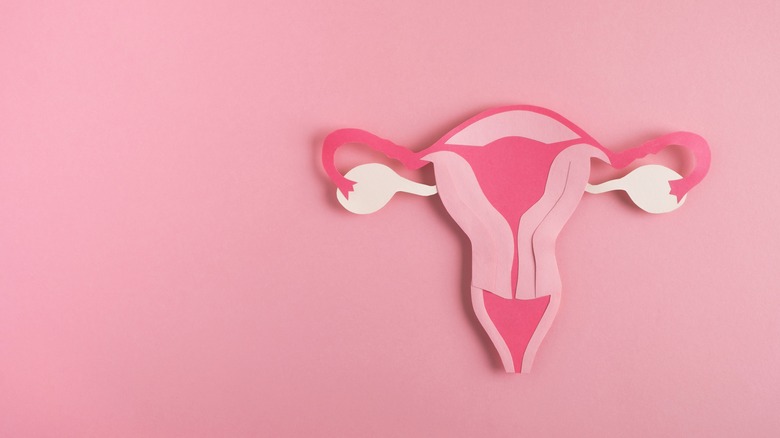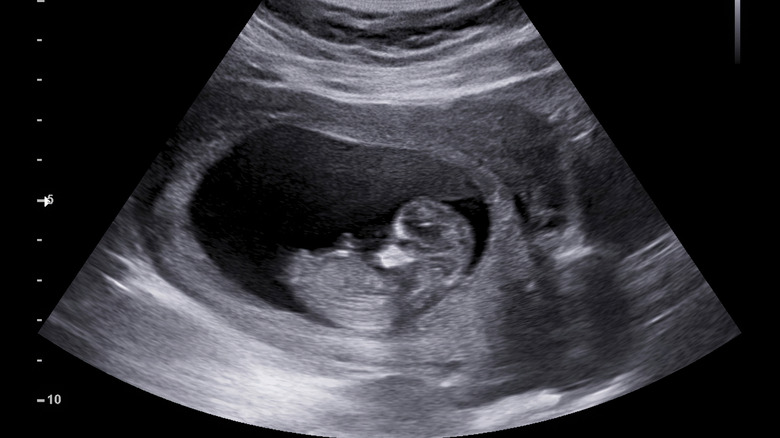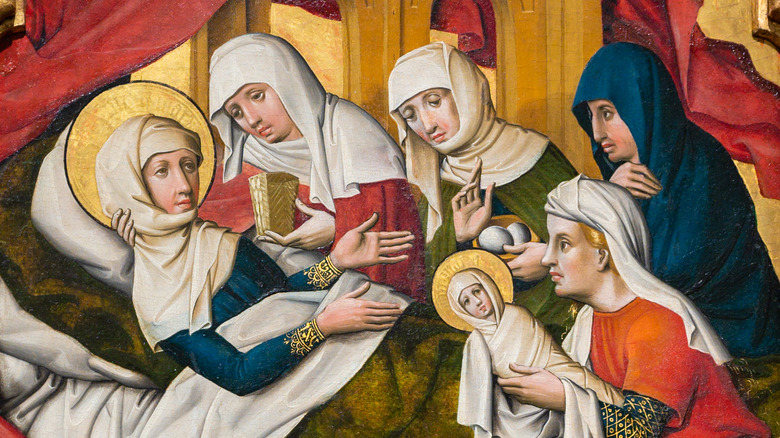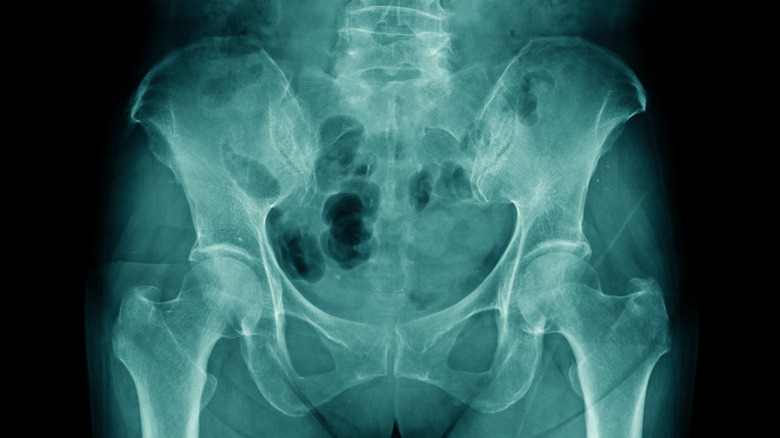The Woman Who Carried A Mummified Fetus Inside Her For 50 Years
By the end of nine months, most pregnant people are thrilled to finally get their baby out of them and into the world. With all the side effects of pregnancy — including morning sickness, swelling, and back pain — putting strain on a mother's body, the 40 weeks of pregnancy can seem endless. But you might be surprised to learn that not all pregnancies end after 40 weeks — and no, we're not talking about elephant pregnancies, though their 95-week gestations are unlikely to inspire much envy amongst human mothers (via Live Science).
In some cases, when a fetus dies prematurely, the baby can actually stay inside the mother's body indefinitely. Called lithopedion, this phenomenon sees a fetus calcifying inside of the mother's body until it appears somewhat rocky. For this reason, lithopedions are sometimes called stone babies (via Atlas Obscura). Exceedingly rare, lithopedions can remain hidden for years before they're diagnosed, as was the case for a 92-year-old Chilean woman named Estela Melendez (via CBS News).
How lithopedions form
Most lithopedions are the result of an abdominal pregnancy, a type of ectopic pregnancy (via Psychology Today). An ectopic pregnancy means a gestation that occurs outside of the uterus (via Planned Parenthood). Ectopic pregnancies are quite rare, making up only about 1-2% of all of them, according to SciELO Brazil. Of those pregnancies, only about 1.4% are abdominal, meaning a pregnancy that occurs in the abdomen instead of in a fallopian tube or ovary. And of all abdominal pregnancies, less than 2% end up as lithopedions. So, as you can see, the phenomenon of lithopedions is rather rare. In total, only 0.0054% of pregnancies lead to lithopedions (via the Indian Journal of Radiology and Imaging).
Ectopic pregnancies can fail for a variety of reasons. Often, a lack of blood supply to the fetus can lead to its death, according to ABC News. Other times, a baby can make it nearly to full term, according to Atlas Obscura. But since it's not within the uterus, it has no connection to the birth canal; in other words, it has nowhere to go. Eventually, if it can't be born, the baby will die.
Why the fetus turns to stone
If the mother's body doesn't do something about the fetus, then the necrotic tissue can threaten her life, according to The Washington Post. If the fetus dies before the third month of pregnancy, the mother's body is able to break down the tissue and reabsorb it, according to Psychology Today. However, when the mother is further along in pregnancy and the fetus is larger, it's too much for her body to handle. In order to protect the mother, a protective barrier must be formed between her and the fetus. That's where calcification comes in.
A lithopedion can calcify in three ways, according to Atlas Obscura. Either the outer membranes surrounding the baby can calcify, but not the baby itself; just the baby can calcify, but not the outer membranes; or both the baby and membranes can calcify. This creates the appearance of the baby turning to stone. In this way, the fetus can stay inside the mother without posing any risk to her. In fact, in many cases, lithopedions are entirely asymptomatic for years (via the Indian Journal of Radiology and Imaging).
History of lithopedions
The phenomenon of lithopedions wasn't discovered by scientists until the last few hundred years, but archeological evidence suggests that lithopedions existed at least as far back as over 3,000 years ago. One set of remains from that time period showed what appeared to be evidence of a lithopedion (via Atlas Obscura). Another story dates back to the 1500s when a French woman went into labor but never actually birthed her baby. She was bedridden for three years recovering from the failed pregnancy and labor before she went on to live another 28 years. When she died, an autopsy was performed, and it revealed a lithopedion of a female fetus in her abdomen. Called the famous Sens baby, this lithopedion went on a tour around Europe before it eventually disappeared after 1826, according to Wonders & Marvels. At the time, doctors didn't know how to explain this phenomenon, so they attributed it to the "coldness" of the woman's uterus, per the same outlet.
Some women with lithopedions experience pain or have a visible bump on their abdomen, according to The Washington Post. Other times, women may experience a heavy sensation in their abdomens or the feeling that their organs are being compressed, Psychology Today reports. Having a lithopedion in your abdomen doesn't necessarily preclude future pregnancies: some women birth babies successfully even before the lithopedion is removed.
The 92-year-old Chilean woman with a lithopedion
Of the more than 300 cases of lithopedions that have been recorded in medical literature, most date far back in history since modern medicine can treat ectopic pregnancies and miscarriages before they turn into lithopedions (via the Indian Journal of Radiology and Imaging). However, there are still some cases of lithopedions being discovered today, including the case of Estela Melendez in Chile in 2015 (via CBS News).
Melendez was 92 when she visited the doctor after an injury. During her examination, the doctor administered X-rays, which revealed a calcified fetus in her abdomen. Further investigation revealed the fetus weighed 4.4 pounds, according to The Washington Post. Unlike most lithopedions, Melendez's stone baby wasn't located in her abdomen but in her uterus. Around 10% of all lithopedions actually die and calcify in the womb (via Psychology Today). In these instances, it is impossible for the mother to get pregnant again, and indeed, Melendez does not have any children. Though it's difficult to exactly date the lithopedion, it's at least 50 years old, according to CBS News.
How the elderly woman was treated
Lithopedions are treated through surgical removal, according to the Indian Journal of Radiology and Imaging. However, lithopedions aren't always removed. When they don't cause symptoms and are found in old or fragile patients, it's often deemed safer to leave them where they are — as was the case with Estela Melendez, whose lithopedion was left undisturbed after it was discovered (via CBS News). Other cases include the case of a Brazilian woman whose lithopedion was diagnosed when she was 60 years old after having presumably been in her abdomen for several decades (via SciELO Brazil). She opted not to have surgery because the stone baby was initially asymptomatic.
Other examples of stone fetuses include rare sets of twins: One pair of conjoined twins died and was mummified at seven months gestation and not discovered for 18 years, according to Psychology Today. When the twins aren't conjoined, one can sometimes be mummified while the other lives and is born healthy, such as in the case of a woman in 1952, whose son was born with his lithopedion twin attached to the back of his head.
